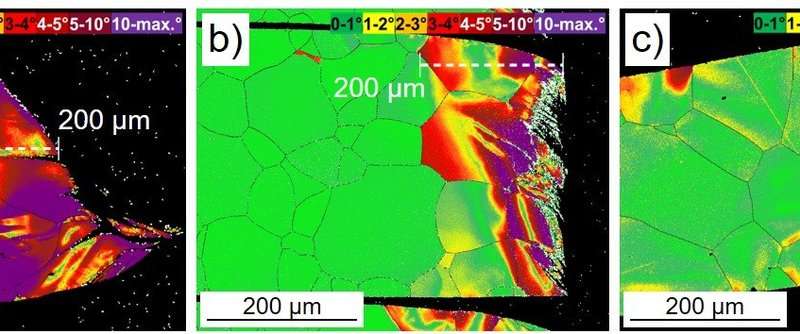
Symmetry of crystal structure can be divided into 230 kinds of space group. Such as the cubic crystal direction for the three rotation symmetry, and the EBSP pattern Kikuchi very six symmetry. Specifically, the rotational symmetry corresponding to the corresponding crystal axis adds center symmetry, that is, 2-rotation symmetry. This rotational symmetry is directly related to the symmetry of the crystal structure. As can be seen from Figure 2, Kikuchi very rotational symmetry. Because Kikuchi corresponds to crystal plane family, Kikuchi is equivalent to the common direction of each crystal family corresponding to each Kikuchi band, that is, the direction of crystal axis. Kikuchi different Kikuchi intersect with the formation of Kikuchi. However, a large tilt angle will lead to the electron beam positioning in the sample surface is not allowed to reduce the sample The spatial resolution of the product surface and other negative effects, so now the EBSD tilt the sample about 70 °.Figure 1 EBSD formation principleThe electron backscatter diffraction pattern contains four sample-related information: crystal symmetry information crystal orientation information crystal integrity information lattice constant information.Figure 2 shows a typical EBSP pattern obtained by the author.The pattern contains several Kikuchi bands corresponding to different crystal faces.Only the crystal family with non-zero structural factor will undergo Bragg diffraction to form the Kikuchi band, while the crystal family with zero structural factor will not form the Kikuchi band due to the zero diffraction intensity. Second, the reason why the sample is tilted about 70 ° is that the larger the tilt angle is, the more backscattered electrons are formed and the stronger the EBSP pattern is formed. Therefore, electron backscatter diffraction is a surface analysis method. The deeper electrons, although Bragg diffraction may also occur, may be further scattered by atoms to change the direction of motion as they further exit the sample surface, eventually becoming the backs of EBSPs. It is worth noting that the EBSP comes from a thin layer of about a few tens of nanometers below the surface of the sample. Receive screen received EBSP Digitized by a CCD digital camera and sent to a computer for calibration and calculation. An EBSP often contains more than one Kikuchi band. An electron backscatter diffraction pattern is called an electron backscatter diffraction pattern (EBSP). The center line of each kikuchi zone corresponds to the cross-section of the plane where the Bragg diffraction occurs from the scattering point of the electron on the sample and the receiving screen, as shown in FIG. Backscattered electrons in the process of leaving the sample with a sample family of crystal face meet the Bragg diffraction condition 2dsinθ = λ that part of the diffraction of the diffraction to form two vertices for the scattering point, and the crystal plane perpendicular to the two conical surfaces, Two conical surface and the receiving screen after the formation of a cross-section of the bright band, the Kikuchi band. This part of the electron is called backscattered electron. A considerable part of the electrons escape the sample surface due to the scattering angle. When the incident electron beam enters the sample, it will be scattered by the atoms in the sample. The sample surface and the horizontal is about 70 °. Can get more than 100 frames per second Kikuchi pattern and calibration results, widely used in geology, microelectronics, materials science and so on.2 The formation principle of EBSD and its contained physical meaningElectronic backscatter diffractometer is usually installed on the SEM or electronic probe.
#ELECTRON BACKSCATTER DIFFRACTION FULL#
With the rapid development of digital cameras, computers and software, the current product EBSD has realized the full automation from pattern reception and collection to calibration.

In the 1990s, automatic patterning was achieved. In the late 1980s, Dingley used screens and television cameras to receive and acquire electron backscatter diffraction patterns. In 1973, Venables and Harland conducted a crystallographic study of the material using electron backscatter diffraction patterns on scanning electron microscopy, opening up the application of EBSD in materials science. Until 1954, Alam, Blackman, and Pashley also used transmission electron microscopy to film the wide-angle kikuchi patterns cleaving LiF, KI, NaCl, PbS2 crystals from film, the first strictly electronic backscatter diffraction. 1 IntroductionThe history of electron backscatter diffraction (EBSD) should be traced back to the band-shaped diffraction pattern seen by Kikuchi in a transmission electron microscope in 1928, the Kikuchi line, although this Kikuchi line is transmitted electronically.


 0 kommentar(er)
0 kommentar(er)
